Harpy

Hybrid monsters They have winged monsters with the bodies of birds and the heads and torsos of women. Harpies like to entrance hapless travelers with their magical songs and lead them to unspeakable torments. Only when a harpy has finished playing with its new “toys” will it release them from suffering by killing and consuming them.These take great glee in the harm and suffering of others, They resemble an evil-faced old human with the lower body, legs, and wings of a bird. Its hair is tangled, filthy, and crusted with the blood of past victims. They typically wear no clothing.
The Harpies were best known for constantly stealing all food from Phineas.
The Harpies were sisters of Iris, daughters of Typhon and Echidna.
Phineas, a king of Thrace, had the gift of prophesy. Zeus, angry that Phineas revealed too much, punished him by putting him on an island with a buffet of food which he could never eat. The Harpies always arrived and stole the food out of his hands right before he could satisfy his hunger, and befouled the remains. This continued until the arrival of Jason and the Argonauts. The Boreads, sons of Boreas, the North Wind, who also could Fly, succeeded in driving the Harpies away but did not kill them, as a request from Iris, who promised that Phineas would not be bothered by the Harpies again, and “the dogs of great Zeus” returned to their “cave in Minoan Crete”. Thankful for their help, Phineas told the Argonauts how to pass the Symplegades.
In this form they were agents of punishment who abducted people and tortured them on their way to Tartarus. They were vicious, cruel and violent. They lived on Strophades. They were usually seen as the personifications of the destructive nature of wind. The Harpies in this tradition, now thought of as three sisters instead of the original two, were: Aello (“storm swift”), Celaeno (“the dark”) also known as Podarge (“fleet-foot”) and Ocypete
(“the swift wing”).
Aeneas encountered Harpies on the Strophades as they repeatedly made off with the feast the Trojans were setting. Celaeno cursed them, saying the Trojans will be so hungry they will eat their tables before they reach the end of their journey. The Trojans fled in fear.
Roleplaying
Source(s) 3.5E Monster Manual I, 3E Monster Manual I, Creature Collection 1, Monstrous Compendium Volume 1, Menace Manual, 1E Monster Manual 1, Basic Boxed Set, Rules Cyclopedia, Classic D&D Game, Monstrous Manual, Warcraft Manual of Monsters
| Harpy | |
| Size/Type | Medium monstrous humanoid |
| Hit Dice | 7d8 (31 hp) |
| Initiative | +2 |
| Speed | 20 ft. (4 squares), Fly 80 ft. (average) |
| Armor Class | 13 (+2 Dexterity, +1 natural), touch 12, flat-footed 11 |
| Base Attack/Grapple | +7/+7 Attack club +7 melee (1d6) |
| Full Attack | club +7/+2 melee (1d6) and 2 claws +2 melee (1d3) |
| Space/Reach | 5 ft./5 ft. 5 ft./5 ft. |
| Special Attacks | Captivating song |
| Special Qualities | Darkvision 60 ft. |
| Saves | Fort +2, Ref +7, Will +6 |
| Abilities | Strength 10, Dexterity 15, Constitution 10, Intelligence 7, Wisdom 12, Charisma 17 |
| Skills | Bluff +11, Intimidate +7, Listen +7, Perform (oratory) +5, Spot +3 |
| Feats | Dodge, Flyby Attack, Persuasive |
| Environment | Temperate marshes |
| Organization | Solitary, pair, or flight (7-12) |
| Challenge Rating | 4 |
| Treasure | Standard |
| Alignment | Usually chaotic evil |
| Advancement | By character class |
| Level Adjustment | +3 |
Combat
When a harpy engages in battle, it prefers to use Flyby Attack and strike with a melee weapon.
Captivating Song (Su)
The most insidious ability of the harpy is its song. When a harpy sings, all creatures (other than harpies) within a 300-foot spread must succeed on a DC 16 Will save or become captivated. This is a sonic mind-affecting charm effect. A creature that successfully saves cannot be affected again by the same harpy’s song for 24 hours. The save DC is Charisma-based.
A captivated victim walks toward the harpy, taking the most direct route available. If the path leads into a dangerous area (through flame, off a cliff, or the like), that creature gets a second saving throw. Captivated creatures can take no actions other than to defend themselves. (Thus, a fighter cannot run away or attack but takes no defensive penalties.) A victim within 5 feet of the harpy stands there and offers no resistance to the monster’s attacks. The effect continues for as long as the harpy sings and for 1 round thereafter. A bard’s countersong ability allows the captivated creature to attempt a new Will save.
Skills
Harpies have a +4 racial bonus on Bluff and Listen checks
HARPY LORE
Originally posted by Eric Cagle
Evandar_TAybara of the Wizards Community forums.
On this Thread
Characters with ranks in Knowledge (Nature) can learn more about harpies. When a character makes a successful skill check, the following lore is revealed, including the information from lower DCs. Knowledge (dungeoneering) can also be used, but all check DCs increase by 5.
Knowledge (Nature)
| DC | Result |
| 12 | This filthy, wretched creature is a harpy. This reveals all monstrous humanoid traits. |
| 17 | Harpies can Fly with average maneuverability and can make Flyby Attacks. |
| 22 | The song of a harpy can captivate living creatures and cause them to approach it. Creatures within 5 feet do nothing, even as the harpy rends them apart. |
| 27 | While not particularly intelligent, harpies are smart enough to set up ambushes. They often ally themselves with more powerful creatures. |

 Buy me a coffee
Buy me a coffee